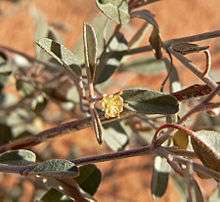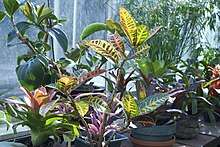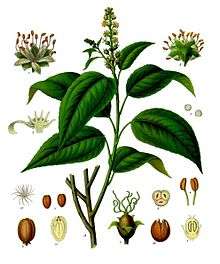Croton (plant)
Croton is an extensive flowering plant genus in the spurge family, Euphorbiaceae. The plants of this genus were described and introduced to Europeans by Georg Eberhard Rumphius. The common names for this genus are rushfoil and croton, but the latter also refers to Codiaeum variegatum. The generic name comes from the Greek κρότος (krótos), which means "tick" and refers to the shape of the seeds of certain species.[2]
| Croton | |
|---|---|
 | |
| Croton californicus | |
| Scientific classification | |
| Kingdom: | Plantae |
| Clade: | Tracheophytes |
| Clade: | Angiosperms |
| Clade: | Eudicots |
| Clade: | Rosids |
| Order: | Malpighiales |
| Family: | Euphorbiaceae |
| Subfamily: | Crotonoideae |
| Tribe: | Crotoneae |
| Genus: | Croton L. |
| Sections | |
|
See text | |
| Diversity | |
| Many species | |
| Synonyms[1] | |
| |
Description
Croton is a diverse and complex taxonomic group of plants ranging from herbs and shrubs to trees.[3] A well-known member of this genus is Croton tiglium, a shrub native to Southeast Asia. It was first mentioned in European literature by Cristóbal Acosta in 1578 as lignum pavanae. The oil, used in herbal medicine as a violent purgative, is extracted from its seeds. Nowadays, it is considered unsafe and it is no longer listed in the pharmacopeias of many countries.[4]
Taxonomy
Uses
Traditional uses
Croton tiglium oil has been used in traditional Chinese medicine to treat severe constipation, heal lesions, and is used as a purgative. It is a source of the organic compound phorbol and its tumor-promoting esters such as 12-O-tetradecanoylphorbol-13-acetate. In the Amazon the red latex from the species Croton lechleri, known as sangre de drago (dragon's blood), is used as a "liquid bandage", as well as for other medicinal purposes, by native peoples.[5]
Food uses
Cascarilla (C. eluteria) bark is used to flavour the liquor Campari and Vermouth.[6]
Biofuel uses
It has recently been shown in Kenya that Croton nuts, such as those from C. megalocarpus,[7] are a more economical source of biofuel than Jatropha. In Kenya, Jatropha requires as much as 20,000 litres of water to make a litre of biofuel, while Croton trees grow wild and yield about .35 litres of oil per kilo of nuts. Croton trees are planted as a windbreak in Kenya and its use as a source of biofuel may benefit rural economies there. As arable land is under population pressure, people have been cutting down the windbreaks to expand farmland. This new use may save the windbreaks which should help fight desertification.
Ecology
Croton species are used as food plants by the larvae of some Lepidoptera species including Schinia citrinellus, which feeds exclusively on the plant,

Distribution
The genus is pantropical, with some species extending into temperate areas.[8] It is one of the largest and most complex genera of angiosperms in Madagascar, where up to 150 Croton species are endemic.[9]
Formerly placed here
|
|
References
| Wikimedia Commons has media related to Croton. |
| Wikispecies has information related to Croton |
- "World Checklist of Selected Plant Families". Retrieved February 28, 2015.
- Gledhill, D. (2008). The Names of Plants (4 ed.). Cambridge University Press. p. 126. ISBN 978-0-521-86645-3.
- Department of Botany, University of Wisconsin-Madison: Croton Research Network
- "Croton - thenurserylakeland". www.thenurserylakeland.com. Retrieved 2020-05-29.
- Raintree Nutrition, Database Entry: Sangre de Grado
- "The Sweet Birthday of a Beloved Bitter". Saveur Magazine. Bonnier Corporation. Retrieved 10 May 2018.
- Milich, Lenard. "Environmental Comparisons of Croton Megalocarpus vs. Other Tropical Feedstocks" (PDF). Archived from the original on 7 July 2011. Retrieved 9 November 2017.CS1 maint: BOT: original-url status unknown (link) Africa Biofuel.
- Croton L., USDA PLANTS
- Schatz, G. E. (2001). Generic tree flora of Madagascar. Royal Botanic Gardens, Kew & Missouri Botanical Garden, St. Louis.
- "GRIN Species Records of Croton". Archived from the original on 20 January 2009. Retrieved 29 November 2010. Germplasm Resources Information Network. United States Department of Agriculture.
